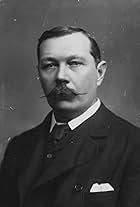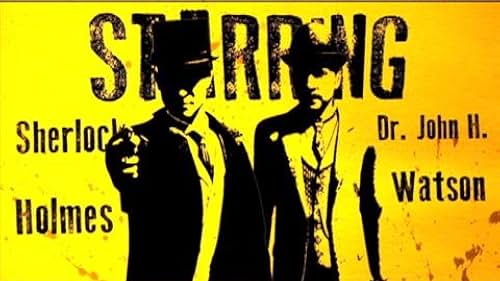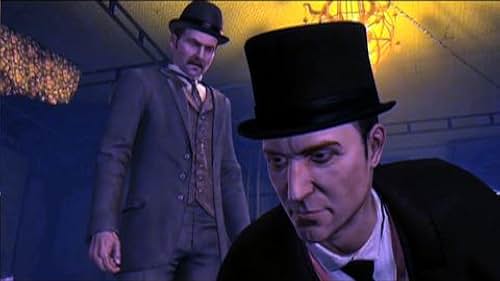Arthur Conan Doyle(1859-1930)
- Writer
- Producer
- Actor
Arthur Conan Doyle was a British writer of Irish descent, considered a major figure in crime fiction. His most famous series of works consisted of the "Sherlock Holmes" stories (1887-1927), consisting of four novels and 56 short stories. His other notable series were the "Professor Challenger" stories (1912-1929) about a scientist and explorer, and the "Brigadier Gerard" stories (1894-1910) about a French soldier in the Napoleonic Wars. Doyle's literary works have frequently been adapted into film and television.
In 1859, Doyle was born in Edinburgh, Scotland to an Irish Catholic family. His father was Charles Altamont Doyle (1832 - 1893), a professional illustrator and water-colorist who is primarily remembered for fantasy-style paintings. Doyle's mother was Mary Foley (1837-1920). Through his father, Doyle was a nephew of the antiquarian James William Edmund Doyle (1822 - 1892), the illustrator Richard Doyle (1824-1883), and the gallery director Henry Edward Doyle (1827 -1893). Doyle's paternal grandfather was the political cartoonist and caricaturist John Doyle (1797-1868).
During his early years, Doyle's family had financial problems due to his father's struggles with depression and alcoholism. They received financial support from affluent uncles, who also financed Doyle's education. From 1868 to 1870, Doyle was educated at Hodder Place, a Jesuit preparatory school located at Stonyhurst, Lancashire. From 1870 to 1875, Doyle attended Stonyhurst College, a Roman Catholic boarding school. He disliked the school due to its rather limited curriculum, and the constant threats of corporal punishment and ritual humiliation used to discipline students.
From 1875 to 1876, Doyle received further education at Stella Matutina, a Jesuit school located at Feldkirch, Austria. His family wanted him to perfect his use of the German language, but this school offered a wider range of study subjects. Stella Matutina attracted student from many countries, and was more cosmopolitan in nature than Doyle's previous schools.
Doyle decided to follow a medical career. From 1876 to 1881, Doyle studied medicine at the University of Edinburgh Medical School. He also took botany lessons at the Royal Botanic Garden in Edinburgh. During his university years, Doyle started writing short stories. He had trouble finding a publisher, and "Blackwood's Magazine" (1817-1980) rejected his submitted work. Doyle's first published short story was "The Mystery of Sasassa Valley" (1879), featuring a demon in South Africa. That same year, Doyle published his first academic article in a science journal. The article examined the uses of the flowering plant Gelsemium as a poison. As an experiment, Doyle self-administrated doses of the poison and recorded the symptoms.
In 1880, Doyle worked for a while as a doctor in the whaling ship "Hope". In 1881, following his graduation from medical school, Doyle served as a ship's surgeon on the SS Mayumba. In 1882, Doyle and a former classmate established a medical practice in Plymouth, Devon. Their partnership failed, and Doyle soon started his own practice in Southsea, Hampshire. He did not have many patients, so he decided to resume writing fiction to supplement his income.
In 1886, Doyle created the character of Sherlock Holmes. He loosely based his creation on his former college teacher Joseph Bell (1837 - 1911), inspired by Bell's emphasis on the importance of "deduction and inference and observation". Doyle completed the first Holmes novel, "A Study in Scarlet" (1887), and sold the rights to the publishing house "Ward, Lock & Co." (1854-1964). The novel's publication was delayed until November, 1887, but it was well-received by professional critics.
Doyle next completed the sequel novel "The Sign of the Four" (1890), commissioned from the American literary magazine Lippincott's Monthly Magazine (1868-1915). He started writing short stories about Holmes for the British literary magazine "The Strand Magazine" (1891-1950).
Besides Holmes stories, Doyle wrote seven historical novels between 1888 and 1906. He wrote "Micah Clarke" (1889), as a fictionalized account of the Monmouth Rebellion (1685) and its consequences. The novel also voices Doyle's arguments against religious extremism. He wrote "The White Company" (1891) to examine the role of mercenaries in 14th-century warfare, depicting the campaigns of Edward the Black Prince (1330-1376) in the Kingdom of Castile. He wrote "The Great Shadow" (1892) to feature the experiences of soldiers in the Battle of Waterloo (1815). He wrote "The Refugees" (1893) to examine the fates of Huguenot refugees who were fleeing 17th-century France to escape religious persecution by Louis XIV (1638-1715, reigned 1643-1715). He wrote "Sir Nigel" (1906) to examine the early phases of the Hundred Years' War (1337 - 1453). He regarded these novels to be his best literary work, though they were never as popular as his crime novels.
In 1900, Doyle served as a volunteer doctor in the Second Boer War in South Africa (1899-1902), though he had no previous military experience. He was stationed at a field hospital at Bloemfontein. At about this time, Doyle wrote the non-fiction book "The Great Boer War" (1900), which covered in detail the early phases of the war. He also wrote the companion work "The War in South Africa: Its Cause and Conduct" in order to defend the British Empire from accusations of misconduct in its military efforts. These works were translated in multiple languages, and were appreciated by the British government. For his services to the British Empire, Doyle was knighted in 1902. In 1903, Doyle became a knight of the Order of Saint John, a British royal order of chivalry that was based on the original Knights Hospitaller.
In 1906, Doyle was involved in efforts to exonerate the lawyer George Edalji, a mild-mannered man who had been convicted of animal mutilations on insufficient evidence. Doyle helped publicize other instances of miscarriages of justice, and convinced the public that there was need of reforms in the legal system. In 1907, British authorities reacted to this campaign by establishing the Court of Criminal Appeal.
In 1909, Doyle wrote the non-fiction work "The Crime of the Congo" (1909). In the book, Doyle denounced the human rights abuses in the Congo Free State, and claimed that the Belgian colonial forces had enslaved the local population. He quoted testimonies from many witnesses and tried to convince the public of a need to intervene in the area.
World War I (1914-1918) was a difficult time for Doyle , as several of his relatives and friends died due to the war. Doyle's son Kingsley was seriously wounded in the Battle of the Somme (1916), and never fully recovered. Kingsley died of pneumonia in 1918, while still hospitalized. Doyle's brother, Brigadier-general Innes Doyle, died of pneumonia in 1919. Doyle's brother-in-law, the famous author E. W. Hornung, died of pneumonia in 1921. The series of deaths led Doyle to further embrace Spiritualism, and that faith's claims about existence beyond the grave. He spend much of the 1920s as a missionary of Spiritualism, and investigated supposed supernatural phenomena. He also wrote many non-fiction spiritualist works. In 1926, Doyle financed the construction of a Spiritualist Temple in Camden, London.
In July 1930, Doyle suffered a heart attack while staying in his then-residence, Windlesham Manor, in Crowborough, Sussex. He spend his last moments in reassuring his wife Jean Leckie that she was wonderful. He was 71-years-old at the time of his death. He was survived by two sons and two daughters. His daughter Jean Conan Doyle (1912 - 1997) was the copyright holder of much of her father's works until her own death.
Since Doyle was no longer a Christian at the time of his death, his family declined giving him a Christian burial place. Doyle was buried in Windlesham Manor's rose garden. His remains were later re-interred in Minstead churchyard, New Forest, Hampshire. His wife's remains were buried beside him. His gravestone epitaph described him as "Steel true/Blade straight/Arthur Conan Doyle/Knight/Patriot, Physician and man of letters".
Doyle is long gone, but his works have remained popular into the 21st century. Doyle has been cited as an influence on later crime writers, and Agatha Christie's earliest novels were strongly influenced by Sherlock Holmes' stories. His life's events have inspired several biographies, and a number of fictionalized accounts.
In 1859, Doyle was born in Edinburgh, Scotland to an Irish Catholic family. His father was Charles Altamont Doyle (1832 - 1893), a professional illustrator and water-colorist who is primarily remembered for fantasy-style paintings. Doyle's mother was Mary Foley (1837-1920). Through his father, Doyle was a nephew of the antiquarian James William Edmund Doyle (1822 - 1892), the illustrator Richard Doyle (1824-1883), and the gallery director Henry Edward Doyle (1827 -1893). Doyle's paternal grandfather was the political cartoonist and caricaturist John Doyle (1797-1868).
During his early years, Doyle's family had financial problems due to his father's struggles with depression and alcoholism. They received financial support from affluent uncles, who also financed Doyle's education. From 1868 to 1870, Doyle was educated at Hodder Place, a Jesuit preparatory school located at Stonyhurst, Lancashire. From 1870 to 1875, Doyle attended Stonyhurst College, a Roman Catholic boarding school. He disliked the school due to its rather limited curriculum, and the constant threats of corporal punishment and ritual humiliation used to discipline students.
From 1875 to 1876, Doyle received further education at Stella Matutina, a Jesuit school located at Feldkirch, Austria. His family wanted him to perfect his use of the German language, but this school offered a wider range of study subjects. Stella Matutina attracted student from many countries, and was more cosmopolitan in nature than Doyle's previous schools.
Doyle decided to follow a medical career. From 1876 to 1881, Doyle studied medicine at the University of Edinburgh Medical School. He also took botany lessons at the Royal Botanic Garden in Edinburgh. During his university years, Doyle started writing short stories. He had trouble finding a publisher, and "Blackwood's Magazine" (1817-1980) rejected his submitted work. Doyle's first published short story was "The Mystery of Sasassa Valley" (1879), featuring a demon in South Africa. That same year, Doyle published his first academic article in a science journal. The article examined the uses of the flowering plant Gelsemium as a poison. As an experiment, Doyle self-administrated doses of the poison and recorded the symptoms.
In 1880, Doyle worked for a while as a doctor in the whaling ship "Hope". In 1881, following his graduation from medical school, Doyle served as a ship's surgeon on the SS Mayumba. In 1882, Doyle and a former classmate established a medical practice in Plymouth, Devon. Their partnership failed, and Doyle soon started his own practice in Southsea, Hampshire. He did not have many patients, so he decided to resume writing fiction to supplement his income.
In 1886, Doyle created the character of Sherlock Holmes. He loosely based his creation on his former college teacher Joseph Bell (1837 - 1911), inspired by Bell's emphasis on the importance of "deduction and inference and observation". Doyle completed the first Holmes novel, "A Study in Scarlet" (1887), and sold the rights to the publishing house "Ward, Lock & Co." (1854-1964). The novel's publication was delayed until November, 1887, but it was well-received by professional critics.
Doyle next completed the sequel novel "The Sign of the Four" (1890), commissioned from the American literary magazine Lippincott's Monthly Magazine (1868-1915). He started writing short stories about Holmes for the British literary magazine "The Strand Magazine" (1891-1950).
Besides Holmes stories, Doyle wrote seven historical novels between 1888 and 1906. He wrote "Micah Clarke" (1889), as a fictionalized account of the Monmouth Rebellion (1685) and its consequences. The novel also voices Doyle's arguments against religious extremism. He wrote "The White Company" (1891) to examine the role of mercenaries in 14th-century warfare, depicting the campaigns of Edward the Black Prince (1330-1376) in the Kingdom of Castile. He wrote "The Great Shadow" (1892) to feature the experiences of soldiers in the Battle of Waterloo (1815). He wrote "The Refugees" (1893) to examine the fates of Huguenot refugees who were fleeing 17th-century France to escape religious persecution by Louis XIV (1638-1715, reigned 1643-1715). He wrote "Sir Nigel" (1906) to examine the early phases of the Hundred Years' War (1337 - 1453). He regarded these novels to be his best literary work, though they were never as popular as his crime novels.
In 1900, Doyle served as a volunteer doctor in the Second Boer War in South Africa (1899-1902), though he had no previous military experience. He was stationed at a field hospital at Bloemfontein. At about this time, Doyle wrote the non-fiction book "The Great Boer War" (1900), which covered in detail the early phases of the war. He also wrote the companion work "The War in South Africa: Its Cause and Conduct" in order to defend the British Empire from accusations of misconduct in its military efforts. These works were translated in multiple languages, and were appreciated by the British government. For his services to the British Empire, Doyle was knighted in 1902. In 1903, Doyle became a knight of the Order of Saint John, a British royal order of chivalry that was based on the original Knights Hospitaller.
In 1906, Doyle was involved in efforts to exonerate the lawyer George Edalji, a mild-mannered man who had been convicted of animal mutilations on insufficient evidence. Doyle helped publicize other instances of miscarriages of justice, and convinced the public that there was need of reforms in the legal system. In 1907, British authorities reacted to this campaign by establishing the Court of Criminal Appeal.
In 1909, Doyle wrote the non-fiction work "The Crime of the Congo" (1909). In the book, Doyle denounced the human rights abuses in the Congo Free State, and claimed that the Belgian colonial forces had enslaved the local population. He quoted testimonies from many witnesses and tried to convince the public of a need to intervene in the area.
World War I (1914-1918) was a difficult time for Doyle , as several of his relatives and friends died due to the war. Doyle's son Kingsley was seriously wounded in the Battle of the Somme (1916), and never fully recovered. Kingsley died of pneumonia in 1918, while still hospitalized. Doyle's brother, Brigadier-general Innes Doyle, died of pneumonia in 1919. Doyle's brother-in-law, the famous author E. W. Hornung, died of pneumonia in 1921. The series of deaths led Doyle to further embrace Spiritualism, and that faith's claims about existence beyond the grave. He spend much of the 1920s as a missionary of Spiritualism, and investigated supposed supernatural phenomena. He also wrote many non-fiction spiritualist works. In 1926, Doyle financed the construction of a Spiritualist Temple in Camden, London.
In July 1930, Doyle suffered a heart attack while staying in his then-residence, Windlesham Manor, in Crowborough, Sussex. He spend his last moments in reassuring his wife Jean Leckie that she was wonderful. He was 71-years-old at the time of his death. He was survived by two sons and two daughters. His daughter Jean Conan Doyle (1912 - 1997) was the copyright holder of much of her father's works until her own death.
Since Doyle was no longer a Christian at the time of his death, his family declined giving him a Christian burial place. Doyle was buried in Windlesham Manor's rose garden. His remains were later re-interred in Minstead churchyard, New Forest, Hampshire. His wife's remains were buried beside him. His gravestone epitaph described him as "Steel true/Blade straight/Arthur Conan Doyle/Knight/Patriot, Physician and man of letters".
Doyle is long gone, but his works have remained popular into the 21st century. Doyle has been cited as an influence on later crime writers, and Agatha Christie's earliest novels were strongly influenced by Sherlock Holmes' stories. His life's events have inspired several biographies, and a number of fictionalized accounts.
























